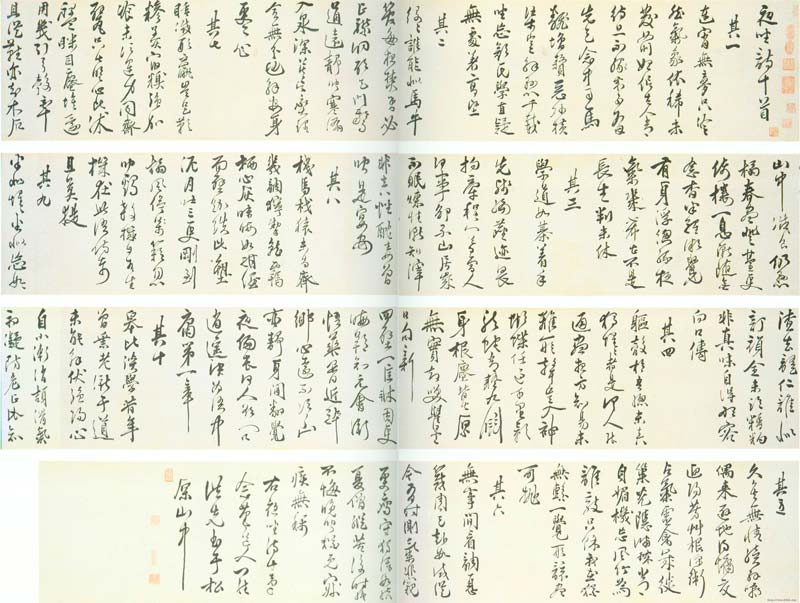Luo Hongxian (1504-1564), whose courtesy name was Dafu and whose name was Nian'an, was born in Huangchengxi, Jishui, Ji'an Prefecture (now Gucun, Jishui County) in the Ming Dynasty. Luo Hongxian came from an official family. He was serious and did not play for fun since he was a child. He determined to be a scholar since he was a child. In the fifth year of Jiajing's reign (1526), Luo Hongxian took part in the provincial examination and passed the examination. In the eighth year of Jiajing's reign (1529), he passed the imperial examination and ranked first in the imperial examination, and was awarded the title of compilation. At that time, Emperor Shizong of the Ming Dynasty was superstitious about Taoism and sought longevity, and his politics were extremely corrupt. Luo Hong first saw the corruption in the court and asked to return. In the eighteenth year of Jiajing's reign (1539), he served as a court official, but was dismissed because he offended Emperor Sejong by co-signing the "Donggong Chaohe Shu". From then on, Luo Hongxian left officialdom and began his life as a scholar. After he returned home to farm, he lived in seclusion in the mountains and devoted himself more to studying Wang Shouren's studies. He thanked guests behind closed doors, sat silently on his couch, and did not leave his house for three years. He was willing to be indifferent, practicing Sanjiu in winter and Sanfu in summer, practicing archery on horseback, studying maps and observing history, covering everything from astronomy, geography, rituals and music, regulations, water conservancy, frontier fortresses, battle formations, offense and defense, to yin and yang, and magic. Explore carefully. In the first year of Longqing (1564), Luo Hong died at the age of 61. He was given the imperial edict to Guanglu Shaoqing with the posthumous title Wengong.
Luo Hongxian's main achievements in his life were in Neo-Confucianism and cartography, and he also had certain attainments in literature. In particular, he made outstanding contributions to cartography. The two volumes of "Guang Yu Tu" he carefully drew are the earliest provincial atlases in the history of our country. Luo Hongxian's achievements in map drawing not only contributed to my country's map drawing and geographical science, but also attracted the attention of international colleagues and occupied a place in world map drawing.
His literary ideas underwent three major changes in the course of his literary practice. At first, he followed Li Mengyang, opposed the frivolous Taige style, and advocated restoration; but later he gradually realized that the restoration school blindly emphasized that "literature must be from the Qin and Han Dynasties, poetry must be from the prosperous Tang Dynasty", and exclusively imitated the ancients from words and sentences, which not only restricted the writer's thoughts, but also made him When the works were divorced from reality, they consciously gave up this literary idea and joined the Tang and Song Dynasty schools such as Tang Shunzhi and Gui Youguang, who advocated "opening the mouth to the throat" in writing and opposed imitating the ancients. Oppose imitation of ancient texts. The poems and essays he wrote not only got rid of the traces of the imitation of the ancients, but also lacked the moral spirit of the Tang and Song Dynasty schools.
In Neo-Confucianism, Luo Hongxian was a backbone figure in the Jiangyou Wang Sect, but he never reached the Shouren Sect. He once studied under the Wang Sect scholars Huang Honggang and He Tingren, studied Wang Shouren's purpose of "promoting knowledge", and worked with the Wang Sect's senior disciples Qian Dehong and Wang Ji. , Zou Shouyi and others have close friendships with each other. After returning home, he built a stone lotus cave and built a formal school where he studied. The evolution of Luo Hongxian's thoughts revolves around Wang Shouren's theory of "promoting conscience". Like Wang Shouren, his theory leaves people's social nature and talks about abstract human nature. However, as far as his entire ideological tendency is concerned, it has the characteristics of moving from fiction to reality. .
He is the author of 22 volumes of "Nian'an Collection", which is included in "Sikuquanshu". There are also "Winter Journey" and "Guang Yu Tu" handed down to the world.

Luo Hongxian's "Sitting at Night in Running Script"








